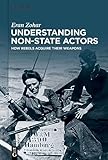Understanding Non-State Actors : How Rebels Acquire Their Weapons / Eran Zohar.
Material type: TextPublisher: Berlin ; Boston : De Gruyter, [2023]Copyright date: ©2023Description: 1 online resource (XI, 424 p.)Content type:
TextPublisher: Berlin ; Boston : De Gruyter, [2023]Copyright date: ©2023Description: 1 online resource (XI, 424 p.)Content type: - 9783111065373
- 9783111065847
- 9783111065557
- 327.1/17 23/eng/20231102
- JC328.6 .Z64 2023
- online - DeGruyter
- Issued also in print.
| Item type | Current library | Call number | URL | Status | Notes | Barcode | |
|---|---|---|---|---|---|---|---|
 eBook
eBook
|
Biblioteca "Angelicum" Pont. Univ. S.Tommaso d'Aquino Nuvola online | online - DeGruyter (Browse shelf(Opens below)) | Online access | Not for loan (Accesso limitato) | Accesso per gli utenti autorizzati / Access for authorized users | (dgr)9783111065557 |
Frontmatter -- Acknowledgements -- Contents -- Introduction: The Theoretical Framework of NSAs’ Arming -- Part 1: The Arming of Non-State Actors in the Pre-Globalization Era -- Chapter 1 The Arming of Ancient and Medieval NSAs -- Chapter 2 NSAS’ Arming from Early Colonialism to the French Revolution -- Chapter 3 Armament – A Key Factor in NSAS’ Struggle Against Colonialism from the Nineteenth Century until the End of the Second World War -- Chapter 4 The Arming of NSAS During the Cold War and De-Colonialism (1945–1990) -- Part 2: The Arming of Non-State Actors in the Era of Globalization -- Chapter 5 Post-Cold War Trends in the Arming of NSAs -- Chapter 6 NSAS’ Funding and Use of IEDS and Suicide Bombing -- Chapter 7 Iran Arming of Its Close NSAS -- Part 3: Constructing a Theory -- Chapter 8 A Theory of Non-State Actors’ Arming -- Conclusion -- Tables and Figures -- Index
restricted access online access with authorization star
http://purl.org/coar/access_right/c_16ec
Understanding Non-State Actors aims to reduce the scarcity of academic literature on armed non-state actors (NSAs) that have always been a part of world politics and wars. This monograph offers, possibly for the first time, a systematic historical review as well as a substantive theory of NSAs and their arming efforts. The world has been astonished by the ability of the well-armed Hamas to inflict heavy losses on the powerful Israel. Thus, from the Jewish rebellion against Rome to the war between the Ukrainian separatists and the Ukrainian government, NSAs’ weapons acquisition has been vital for the build-up of their force, enabling both the employment of that force and its sustainability. While weapons are not necessarily the most important factor in military build-up, NSAs need weapons to fight, and revolts usually erupt after the organizers have acquired a certain number of weapons. Conversely, many revolts lose momentum and operations are not carried out, or turn ineffective, due to shortages of arms and ammunition. A major theme of this monograph is that in spite of dramatic political and technological changes, armed NSAs in different periods have employed similar methods to acquire weapons. Self-production, looting and stealing, external support, and the arms trade were always the major ways for NSAs to acquire weapons, though the importance of each method and the type of arms has changed remarkably over time. Understanding Non-State Actors discusses the factors – political, social, cultural, technological, and organizational – that have both facilitated and constrained the ability of NSAs to acquire arms. Especially, lecturers and students of Military, Terrorism, Conflict studies, War and peace studies will benefit from this study.
Issued also in print.
Mode of access: Internet via World Wide Web.
In English.
Description based on online resource; title from PDF title page (publisher's Web site, viewed 26. Apr 2024)


